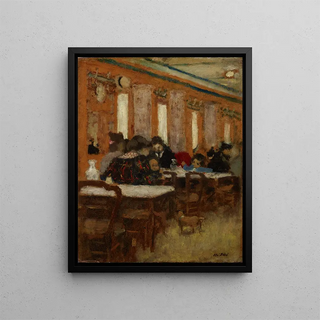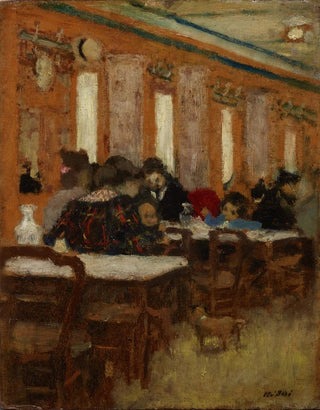Art print | Le Petit Restaurant - Édouard Vuillard


View from behind

Frame (optional)
"Le Petit Restaurant" by Édouard Vuillard is an iconic artwork that evokes the intimacy of shared moments in a convivial setting. This painting, created at the end of the 19th century, captures a scene of everyday life where soft light and warm colors intertwine to create an atmosphere that is both peaceful and lively. The piece invites the viewer to immerse themselves in a universe where time seems suspended, where every detail tells a story. Vuillard, with his unique sensitivity, manages to transform a simple restaurant into a place of encounter and emotion, making this canvas a true masterpiece of intimate painting.
Style and uniqueness of the work
Vuillard's style is distinguished by a decorative approach and bold use of patterns. In "Le Petit Restaurant," he plays with textures and colors to bring life to the characters and their environment. The human figures, although stylized, exude warmth and proximity that bring the viewer closer to the scene. The shades of color, ranging from soft tones to more vivid hues, create a visual dynamic that attracts the eye and invites exploration. This painting also stands out for its composition, where the arrangement of elements reinforces the idea of conviviality and sharing. Vuillard, by incorporating elements of everyday life into his art, manages to transcend simple realism to offer a poetic vision of reality.
The artist and his influence
Édouard Vuillard, a major figure of the Nabi movement, mastered the blending of Impressionism and Symbolism to forge a personal and recognizable style. Born in 1868, he was deeply influenced by his environment, notably by Parisian salons and the artistic life of his era. His work is not limited to painting but also extends to interior decoration and illustration, reflecting his desire to integrate art into daily life. Vuillard captured the essence of human relationships and simple moments, thus influencing many 20th-century artists. His ability to evoke emotions through ordinary scenes paved the way for a new approach to artistic representation, where intimacy and everyday life take precedence over the spectacular.

Matte finish

View from behind

Frame (optional)
"Le Petit Restaurant" by Édouard Vuillard is an iconic artwork that evokes the intimacy of shared moments in a convivial setting. This painting, created at the end of the 19th century, captures a scene of everyday life where soft light and warm colors intertwine to create an atmosphere that is both peaceful and lively. The piece invites the viewer to immerse themselves in a universe where time seems suspended, where every detail tells a story. Vuillard, with his unique sensitivity, manages to transform a simple restaurant into a place of encounter and emotion, making this canvas a true masterpiece of intimate painting.
Style and uniqueness of the work
Vuillard's style is distinguished by a decorative approach and bold use of patterns. In "Le Petit Restaurant," he plays with textures and colors to bring life to the characters and their environment. The human figures, although stylized, exude warmth and proximity that bring the viewer closer to the scene. The shades of color, ranging from soft tones to more vivid hues, create a visual dynamic that attracts the eye and invites exploration. This painting also stands out for its composition, where the arrangement of elements reinforces the idea of conviviality and sharing. Vuillard, by incorporating elements of everyday life into his art, manages to transcend simple realism to offer a poetic vision of reality.
The artist and his influence
Édouard Vuillard, a major figure of the Nabi movement, mastered the blending of Impressionism and Symbolism to forge a personal and recognizable style. Born in 1868, he was deeply influenced by his environment, notably by Parisian salons and the artistic life of his era. His work is not limited to painting but also extends to interior decoration and illustration, reflecting his desire to integrate art into daily life. Vuillard captured the essence of human relationships and simple moments, thus influencing many 20th-century artists. His ability to evoke emotions through ordinary scenes paved the way for a new approach to artistic representation, where intimacy and everyday life take precedence over the spectacular.






